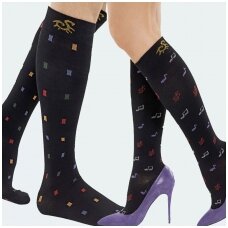Kuidas valida õiget veenilaiendite tugisukade
-

The most important things to consider while choosing compression stockings are compression level, model and size.
Compression is measured in mmHg and is indicated for each product. You will always find two figures (eg. 15/18 mmHg) – whereas the higher figure indicates compression of lower part of the products and lower – at the upper part of the product. Such gradually decreasing compression ensures smooth leg vein blood circulation, helps to pump blood from bottom to top. According to European Union standards UNI ENV 12718, compression products are divided into classes according to compression level. Below in this article you will find a table, which will help you to evaluate what compression level you need. By the way, compression stockings with compression level up to 18/21 mmHg (140 den) are recommended to wear for preventive purposes, even if you don‘t have any vein problems. This is particularly important for those who's jobs are related with long standing or sitting, especially with long flights or car trips. More about venous diseases and compression therapy.
Model. The offer is really wide - tights, leggings, hold ups, socks; opaque and transparent, classic and patterned; open and closed fingers ... Main Solidea products structured according to the model and the level of compression you will find in the table below, we hope that it will help you to make a choice.
Size. Usually it is recommended to chose the size according to weight and height ratio table (for tights, leggings and hold ups) or shoe size for socks. Size charts are listed under each item, but here are some general tips:
• If the height and weight ratio is borderline between two sizes, it is recommended to choose smaller size.
• Pregnant women are recommended to choose according their the height and weight before pregnancy.
• Patients with diabetes are recommended to choose a model with open toes
• In all cases, especially if you have a non-standard figure or your legs are especially swollen, it is recommended to doublecheck with the circumferences table. It is recommended to make measurements in the morning, when your legs are not swollen yet.If you have any questions about the size, model or compression, we will be always happy to advise you by phone +370 686 17010, or e-mail info@silueta.lt
Preventive and therapeutic stockings, tights and supports are classified, regarding compression, in compliance with Experimental European Standard UNI ENV 12718.
WHEN NOT TO USE GRADUATED COMPRESSION
Graduated compression should not be used in the presence of the following pathologies:
- Arterial pathology: compression of small size arteries would further reduce blood passage, creating pain and reduced blood supply
- Diabetes with neuropathy (pain of peripheral nerves following alteration of glucose metabolism)
- Moist dermatosis (reddened skin, abraded surface, secretion of serous fluid)
- Ongoing skin ulcer( not caused by venous insufficiency)
- Crural eczema
- Disorders of arterial circulation
- Raynaud’s disease (arterial pathology with damage to the artery wall)
INDICATIONS
Class mmHg Den (only Solidea) Indications A (preventive) 10–14 30 den – 8/11 mmHg
70 den - 12/15 mmHg- Predisposed persons
- Swollen legs, mild oedema, teleangiectasias
- Pregnancy
CLASS I Light 15–17 100 den – 15/18 mmHg - Predisposed persons
- Swollen legs, mild oedema, teleangiectasias
- Post-sclerotherapy of telangiectasias
- Varicose veins
- Oedema during pregnancy
CLASS I Hight 18–21 140 den – 18/21 mmHg - Predisposed persons
- Swollen legs, mild oedema, teleangiectasias
- Varicose veins
- Truncal varicose veins
- Varicose veins with substantial oedema
- Post-varicectomy
- Post-sclerotherapy
- Arthrosis of the foot and knee
CLASS II 23–32 25/32 mmHg - Post-thrombotic syndrome
- During treatment of ulcers
- Post-trauma treatment
- Angiodysplasias
- Deep venous thrombosis
- Deep venous insufficiency
- Reversible lymphoedema
CLASS III 34-36 34-36 mmHg - Severe edema
- Chronic hypodermititis
- Irreversible lymphedema
